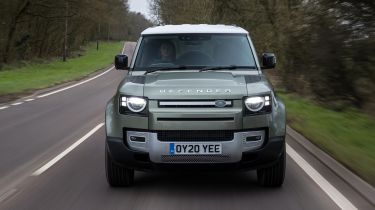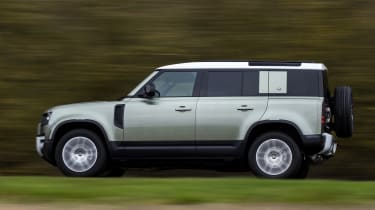Land Rover Defender review - MPG, running costs & CO2
"High running costs are inevitable, but buyers can mitigate this by opting for the plug-in hybrid and charging as often as possible"
When it first launched, Defender buyers were able to choose between diesel and petrol engines, some of which had mild-hybrid assistance. Sadly, none of them provide especially low running costs, but the plug-in hybrid P400e and P300e offer far more impressive fuel efficiency figures. These versions will likely appeal to company-car drivers, while at the other end of the spectrum, there's also a range-topping V8 model for anyone who wants the ultimate performance, regardless of cost.
For the most part, Land Rover clearly prioritised performance, versatility and rugged looks over fuel-efficiency – just as it did with the original. Even the most economical diesel version of the new Defender only just manages to tip over 30mpg, while high official CO2 emissions figures mean company-car drivers will face a hefty Benefit-in-Kind bill.
Unlike the original Landie, which had the same commercial status as a van or pickup, the new Defender 90 and 110 are classed as private vehicles, with the van-like 90 and 110 Hard Top the only versions falling into the commercial vehicle category.
Land Rover Defender MPG & CO2
The Defender was launched with two diesel 'Ingenium' 2.0-litre turbo engines badged D200 and D240, returning up to 32.2mpg in the 90 and 31.7mpg in the Defender 110. CO2 emissions span from 230-253g/km (WLTP).
More reviews
These were replaced in 2021, with a new 3.0-litre straight-six diesel engine boasting mild-hybrid tech. The D250 version of this engine can manage around 34mpg, a figure which is closely matched by the more powerful D300 model. The D250 emits from between 219 and 226g/km of CO2, while the D300 has emissions figures from 220 to 229g/km of CO2, placing them firmly into the top BiK band for business drivers. In 2024, the D300 was replaced by the more powerful D350, which achieves virtually the same fuel economy and CO2 figures.
The 2.0-litre turbo petrol P300 gets an official fuel economy figure of 26mpg, with CO2 emissions of at least 246g/km – the same ballpark figures as the 3.0-litre P400 mild-hybrid. We don’t recommend either of these engines for anyone covering high miles, or for those looking to reduce their annual fuel bills.
Defenders fitted with the V8 engine in P425, P500 and P525 trim are considerably worse on fuel, with official figures of around 20mpg for all three engines. CO2 emissions are also particularly high, ranging from 316g/km in P425 models to 325g/km for the P500.
The Defender Octa is fitted with a smaller mild-hybrid 4.4-litre V8 engine, badged P625, but this model is similarly thirsty on fuel courtesy of its higher turbocharged power output. You can expect up to 21.4mpg from this version. CO2 emissions are at least marginally lower, at 298g/km.
Thanks to its 19.2kWh battery pack, the P400e plug-in hybrid can manage up to 32 miles on electricity alone, giving it official figures of up to 109.4mpg and CO2 emissions of 59-61g/km depending on its trim level and which wheels and tyres are fitted. The P300e plug-in hybrid achieves near-identical fuel efficiency, CO2 and electric-only range figures. This should make both models the cheapest Defenders to run by some margin and the only ones that should be on company-car shopping lists.
The battery can be charged at home using a 7kW wallbox, taking it from 0-100% in two-and-a-half hours. It will also be possible to use a 50kW rapid-charger, for an 80% charge in 30 minutes at compatible public charging points.
Insurance groups
Insurance groups for pricey, complex SUVs tend to be a bit higher than for normal cars. That's certainly the case here, because even the entry-level D250 SE sits in group 34 out of 50. Petrol P300 versions in SE trim start from 36. The plug-in hybrid P400e starts from group 43, but by far the most expensive models to insure will be those equipped with the V8 engine, which start from group 48.
Warranty
Land Rover provides a three-year/unlimited-mileage warranty with its new models, which matches BMW and Mercedes. It's not as generous as some brands, though; the Kia Sorento comes with a seven-year warranty as standard.
Servicing
Land Rover offers servicing plans that can help spread the cost of maintenance, so they're worth exploring with the dealership. It's also worth noting that diesel engines require AdBlue top-ups every so often.










